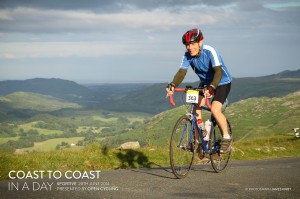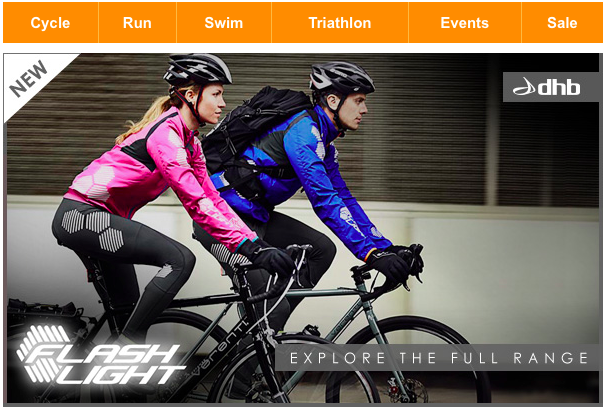“It is not too soon to start a Coast to Coast in a Day training schedule” I said to one of my friends who is extremely curious about doing the 2015 event. He’s not ready to actually say it but I can tell he’s mulling over in his mind: he’s seen the glee and delight on our faces and I think he wants his slice of this next year.
I followed this basic advice by saying he had about 46 weeks to train and then taper for a few weeks before the big day. That seemed to make some sense to him, judging by his body language and I do think he could do it, even though he’s starting from a modest baseline. This got me thinking, what does someone need to do who wants to train for the 150 hilly bike ride? When I say “hilly” I do seriously mean HILLY with 4,500 metres of climbing, including the infamous Hardknott Pass, followed by Wrynose Pass and a few other minor slopes afterwards. I’m saying this having completed the Coast to Coast myself this year, I am not wanting to come across as any kind of authority or expert with this, these are just my thoughts based on my ‘umble experience and hopefully a little bit of common sense. I should add I’m no speed merchant as my time was slower than average (but, it’s not a race!).
Choice of bicycle
My friend will need a road bike with dropped handlebars, for two reasons. Firstly this is the most comfortable and efficient bike for the job. Secondly he won’t be allowed to enter with anything else (unless he’s successful in grovelling and pleading with the organisers).
Within the general term of “road” bike there are many variations with some suitable for time trials, training, sportives and so on. A bike for sportives is ideal as it will more suited to long rides in terms of its comfort. Don’t dismiss the the idea of a fast tourer, or Audax type bike but there are fewer of these around and they don’t quite have the same image. If my friend is feeling flush, a super-light carbon fibre bike might tempt him, or else an aluminium frame is popular with many or a slightly heavier steel frame like mine.
Take care to make sure you get one of the correct size and that it fits well. I won’t go into specifics at this stage as that’s a huge subject on its own. Buying on-line, or in a lesser bike shop, without being sure the fit is right is at your peril. Don’t tell me I didn’t warn you.
Get the gearing right
If you are already pretty fit, light, brave and experienced you can probably manage the climbs on a bicycle with a double chainset. Go for the “compact” type which means it has chain rings with 50 and 34 teeth. It’s the 34t chain ring that will give you the lower range of gears. The largest sprocket at the back should not be less than 28t. Better still, go for 30 or 32t (but you will need to ask the bike shop to change the rear derailleur for you).
Even better is having a triple chainset, as I did, the little chain ring is sometimes referred to as a “granny gear”. On one level this might seem a bit whimpy but I can tell you I appreciated having gears that were 26t x 26t, which meant I had a 1:1 drive. This is not too low for a ride like this and I certainly valued having it.
Clothing
Ideally you’ll need to train or at least cycle regularly through the winter months, spring and into the early summer. Does all this mean spending huge sums of money on clothing? No, you don’t have to as the layering principle applies. Make sure you get some synthetic “technical” jerseys which are great for wearing in a wide range of temperatures and these will help you stay at a good temperature. Gloves, skull cap, winter jacket, winter cycling trousers (tights), over shoes etc are all needed.
Although some of my C2C pals seem to have endless wardrobes, I only have two pairs of cycling shorts – one Lycra and one baggy.
It goes without saying that you need a helmet but my friend already has one A helmet not only helps to preserve your head in the event of a crash but also you probably won’t be allowed to take part unless you have a helmet. If you haven’t already got one, make sure you go and buy one. Do it. If an existing helmet is a few years old and becoming tatty, it may be prudent to replace it.
Shoes
I’d really recommend clip-in / clippy pedals; this is the way to go. Again there’s quite a range but it means you have a special pair of shoes with a stiff sole and a “cleat” bolted to it. The cleat snaps into a clip-in pedal so you are securely attached to the bike! This might sound scary but I reckon 99% of cyclists who have gone these pedals would NEVER go back and this includes me. Whenever I ride a bike without clippy pedals I actually feel unsafe.
Training
There’s no magic formula but these are my thoughts:
- arrange your life so you can cycle 2 or 3 times each week
- make sure you become a regular cyclist – every ride counts, even a short 2 or 3 mile cycle ride counts and helps
- only you will know if you ought to get checked out by your Doctor first of all
- have one long ride each week but build these up gradually i.e. 10 miles, 15 miles, 20 miles etc
- mid week rides are shorter. As your fitness improves you can make these fast rides
- make sure you have a good diet, well balanced everyday
- make sure you get enough sleep
- getting some hills in at some point will be a necessity. In an ideal world it would be good to have experience of a 1:4 or even a 1:3 slope. Depending on where you live these might be in short supply but do see if you can get some steep hills in somehow, even if it means riding up and down the same hill several times in one go
- get used to riding over 100 miles. I recommend at least 3 or 4 rides of 100-140 miles
- always have a rest day (or two) after those long rides
- build the distances gradually but consistently. This way you will have some base fitness to keep you in good shape as there will be times when you’re off the bike for a few weeks (because of “life”, illness, bad weather, injury etc)
- consider buying an indoor turbo trainer to keep you going through those dark, winter months
- keep a log of your progress as a way of adding interest. You can do this by using a smart phone app like Strava or even starting a blog (!)
Your thoughts, things to consider
- look forward, be positive
- believe you can do it and look forward to the satisfaction of completing the Coast to Coast
- are you a loner? Do you prefer to cycle on your own or with a friend?
- once again, do you need the green light from your Doctor?
- you can spend a fortune on cycling related kit, clothing, equipment, bikes, wheels, lights and so on if you want. If you do it via my affiliate link to Wiggle or Evans you are a star. By the same token, you don’t have to
- look forward to better health, cardiovascular health, good sleep patterns, weight and general fitness
Focus on enjoying the whole experience, the real sense of satisfaction and improved health and fitness. Remember cyclists normally live longer than people who don’t.
Related
The pros and cons of cycling the Coast to Coast in a Day





 RSS – Posts
RSS – Posts